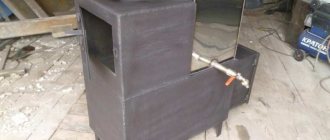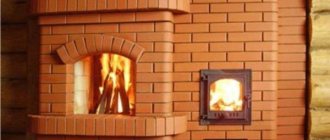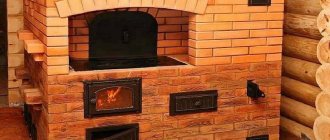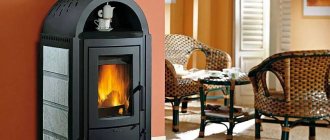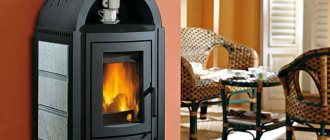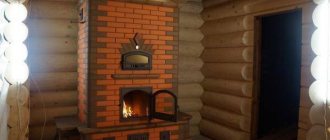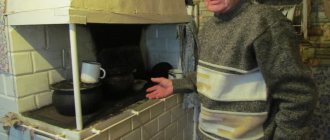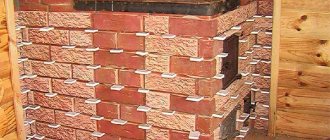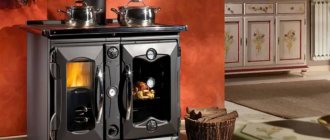When solving the issue of heating for a summer house, you can find many options on the modern market.
Finnish wood stove for a summer residence
And, despite the fact that new technologies are improving more and more every year, many still prefer the good old wood-burning stoves.
Today it is not just a heating device, but also a special decorative element that allows you to give the overall style of the house a certain “zest” and authenticity.
Among the huge selection of heating appliances presented on the domestic market, Finnish stoves occupy a significant share.
A Finnish stove for a summer cottage is a reasonable, compact and effective solution that allows you to quickly warm up a room and maintain the required temperature for a long time. What is the peculiarity of the design, and what characteristics should you choose a Finnish stove for your dacha - we will talk in this article.
Properties of the Finnish stove
The choice of a Scandinavian stove is based on the quality of the manufacturer and the similarity of climatic conditions. The countries of Northern Scandinavia and Russia have very similar climates. They are extremely responsible when it comes to residential heating and heat preservation. When heating a room, a Finnish stove also maintains air humidity.
The structure and structure of the Finnish and classic Russian stoves are similar. The principle of heating a room is carried out by heating the furnace body and gradually releasing this heat into the room.
The Finnish long-burning stove allows you to heat a room for a long time with minimal fuel consumption.
Finnish wood-heated stoves are made of dense cast iron; this type of construction allows you to quickly heat the room. Finnish stoves are distinguished by their compactness and appearance. The Finnish stove can harmoniously fit into any room design. A miniature Finnish stove is suitable for heating a small room.
Finnish stoves not only do a good job of heating the stove, but also protect the house from fire. Finnish stoves are equipped with cast iron doors that prevent coals from falling out. The cast iron door can be replaced with fireproof glass, and you will have something like a small fireplace.
Versions with water circuit
A beautiful heating stove with a water circuit.
They have a water heat exchanger. These versions allow you to heat the entire house. They successfully combine decorative qualities and thermal output. The design features panoramic glass. Through it you can monitor the working flame. The liquid heat carrier circulating in the heat exchanger heats up. This action serves as the basis for heating. These versions can be connected to radiators. For this purpose, there are special taps on their body. The supply and return pipelines are arranged through them.
Such models can be installed in any heating technology: insulated, open, with normal or even forced draft of the coolant.
The structure of the Finnish stove
The Finnish stove consists of five parts:
- Chimney
- Firebox
- Lining
- Kamenka\
- Ash pit (ash pit)
The firebox of a Finnish stove is no different from the classic firebox of a Russian stove.
Firewood or coal is placed in the firebox. The ashpit or ashpit is a chamber in which ash is stored. The chimney (the name speaks for itself) serves to remove smoke outside the house.
- The lining is the lining of the chamber with metal or a dense layer of metal, designed to regulate the temperature in the room.
- The lining preserves the functionality of the furnace when in contact with fire.
- The Finnish stove has two combustion channels that are not connected to each other. They speed up the process of heating a room with minimal consumption of firewood or coal.
- The ash pan or ash pan is equipped with a pull-out container, which allows you to easily clean the oven without resorting to additional tools.
- The cast iron door serves as a mechanism for supplying oxygen to the flame.
Finnish open and closed stoves have a heater that can hold from 20 to 100 kg of coal or firewood.
Finnish stoves heat a room by heating air. Cold air is taken from the floor, enters the stove, heats up and exits into the room through special openings in the stove heaters. Natural air circulation occurs and heats the room.
Long burning versions
The specifics of these modifications are as follows:
- Positions of convective channels. They allow optimal accumulation of heat from the combustion chamber. Cold air ends up inside the housing, passing through special outlets at the bottom of the device. The air masses are rapidly warming up. And warm air fills the room within 2-5 minutes from the start of the kindling.
- Heating of adjacent rooms. Long-burning wood-burning air-heating modifications can be used as a heating base for an entire house. With prolonged combustion, warming up a building with an area of no more than 350 - 400 sq.m is enough. The connection of air ducts is possible due to the design of the housing. Pipes are distributed throughout the building. Each pipe ends up in every room that needs heating.
Some modifications have a compartment in the body where you can store the required amount of firewood. With it, the stove can work for several days.
Privileges of the Finnish stove
Like all household items, the Finnish stove has its pros and cons. Let's look at how the Finnish stove is superior to other types:
- Gradual heating of the air and maintaining a comfortable temperature.
- Safety
- Ease of construction
- Minimum time to heat the room
- An appearance that fits harmoniously into any interior.
- Long term use
- Wood as the main type of fuel for space heating
- Economical fuel consumption
- Maintaining air humidity
The Finnish wood stove is extremely environmentally friendly, since it operates primarily on wood, and during combustion they do not emit any harmful substances that affect humans and nature. In terms of environmental friendliness, Finnish stoves are superior to gas stoves, which emit harmful emissions into nature.
- The main idea of the Finnish stove is maximum economy of fuel used. Even with burnt wood leaving only small coals, the stove generates enough heat to heat the room.
- Due to their compactness, Finnish stoves are installed in small wooden houses. In this regard, manufacturers of Finnish stoves pay great attention to design safety. All parts of the Finnish stove are connected to each other with ceramic tape, increasing its heat resistance.
When using a Finnish stove for a long time, some part may fail, but this will not become a problem. Each oven kit can be purchased and reinstalled. In this case, you do not need to look for parts from exactly one company. They are universal, you can install parts from different manufacturers.
The disadvantages of the Finnish stove include the duration of heating of the structure; to install the Finnish stove, a concrete floor is required. The price of the Finnish stove is also surprising.
Popular manufacturers
Furnaces from Finland have proven themselves to be reliable and economical devices. They have a modern design solution and high-quality “filling”.
Finnish manufacturing companies such as Nunnauuni, Tulikivi, Kota, Kastor, Helo, Harvia, Narvi, Iki, Upo have proven themselves... Let's look at some of them.
More information about Harvia stoves
NunnaUuni - the history of this company begins in 1982. Currently, it offers the buyer furnace equipment that is advanced in the market. Nunnauuni stoves are made with potted stone lining and are characterized by uniform heat transfer and a high level of heat resistance. These are high-power devices (from 40 to 60 kW). In the model range you can see injection stoves, panoramic, tunnel and corner.
Tulikivi is a stone processing company and the largest manufacturer of heat storage fireplaces. In the assortment you can find a fireplace-stove (six collections and more than a thousand models). Tulikivi Finnish stoves can operate for a long time (up to two days) from a single load. They are faced with natural stone, and there are a couple of models in metal.
Wood burning stove Helo 28 SIL
Kota is a relatively young company, but successfully developing in its field (operating since 2012). The manufacturer's furnaces are characterized by versatility despite the simplicity of their design and have high-quality assembly. The power of Kota models is from 4 to 16 kW.
Kastor is a company that dates back to 1908. The products are made from high quality materials. Extensive experience and active use of innovations have made Castor stoves popular for many years. The company's series are ideal for heating residential areas up to 200 m².
Finnish Helo stoves are a more affordable option among stoves from Finland. They can be called analogues of expensive Kastor models. Helo stoves have a simpler design and construction, but their quality characteristics are no worse.
In 2009, Finnish manufacturers Helo and Kastor merged. At this time, they are one company with two brands that manufacture their products on the same equipment.
Choosing a Finnish stove
The functionality of the Finnish stove does not end with heating the room; you can cook food on it, install a boiler for heating water and use it as a fireplace. When choosing a stove, pay attention to:
- Power. The furnace power must be sufficient to heat the building. The manufacturer indicates the power data in the instructions. Please read it carefully before purchasing.
- Duration of keeping warm. The material from which the stove is made affects how long the heat will be maintained. In metal Finnish stoves, heat from firewood can be retained for 8 to 10 hours. Stone ovens can retain heat for up to 20 hours.
- Oven size. The efficiency of heating the room also depends on the size of the stove.
Advantages and disadvantages
Like any equipment, Finnish fireplace stoves have strengths and weaknesses that manifest themselves during operation. The advantages of these devices include the following parameters:
- versatility and excellent quality of stoves;
- maintaining optimal humidity levels;
- use of environmentally friendly fuel;
- high efficiency;
- long operational period.
Finnish stoves also have disadvantages. These include:
- High cost (due to the use of high-quality materials in production).
- Slow heating of rooms.
- The need to arrange a foundation (this is more of a condition rather than a disadvantage).
Finnish sauna stove
A Finnish sauna stove must heat the air from 60 to 90 degrees in a minimum amount of time. A metal Finnish stove is installed in the bathhouse and lined with bricks.
Stones are placed in the heater of a Finnish stove. When in contact with water, they release the necessary steam.
Finnish stoves have become a universal device for heating residential premises and baths. They differ from each other in price and equipment.
Pellet models
Pellet stove
Independent heating of houses is possible with the help of modifications that run on pellets. Moreover, the heating process resembles complete automation. Pellets are press-compressed fuel from waste from the woodworking industry. Specifics of this technique:
- Fuel is supplied automatically.
- Burning pellets produces more heat than burning wood.
- There are versions that focus on heating air and liquid heat carrier.
Pellet versions work using an autonomous method. Automatic devices with microprocessors regulate their operation.
The proportion of air supply and placement of granules into the combustion section is carefully selected. When burning pellets, a tiny amount of unburnt remains in a wood-burning stove. Options for heat distribution between rooms:
- Through air ducts. They are connected to special channels of such models.
- Through heating radiators.
Work on the autonomous principle of heating installations lasts 6-8 hours. When updating the technology of fuel supply and storage, this period develops tenfold.
Photo of a Finnish stove
Fuel type
The operating principle of the equipment may vary.
- Wood-burning structures can be heated not only with wood, but also with other types of solid fuel. They are economical and heat up the room quickly. Such stoves are more traditional: it is pleasant to be in a room where you can hear the crackling of firewood and the air is filled with a pleasant aroma. Wood-burning stove for a sauna
- Electric ovens are plugged into an outlet. They are characterized by greater fire safety, compactness, ease of operation and the ability to adjust the operating mode. The air with such units warms up very quickly. Most often, electric furnaces are installed in saunas or in rooms where it is not possible to install a chimney. But working heating elements change the ionization of the air, which becomes less healthy. Electric sauna stove
- Furnaces in which the fuel is gas are not so common . Combination models are also available that can operate on both wood and gas. Gas sauna stoves are gaining popularity
The ideal option for a stove installed in a steam room is a wood-burning design. In this segment, products from Finnish factories enjoy deserved popularity.
Disadvantages of electric heaters
Why is it so important to ensure healthy warmth in a wooden house?
Wooden houses that use environmentally friendly materials require an optimal microclimate, otherwise the service life of the wood can be greatly reduced. Tulikivi fireplace stoves evenly fill the room with beneficial infrared heat without drying out the air or raising dust. They are functional, beautiful, energy efficient and safe. And each of the advantages should be considered separately in order to understand its features and value.
Tulikivi stone quarry Source tulikivi.ru

